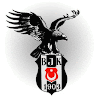The “Leo the Lion” trademark has been the image of Metro-Goldwyn-Mayer for decades. For over 80 years, movie audiences have counted on seeing the roaring lion at the beginning of all MGM films. However, while the logo itself has always been a familiar image, there have been various lions featured throughout the years.
The well-known MGM logo was originally introduced in 1924 for Samuel Goldwyn’s Goldwyn Picture Corporation. The logo was designed by Howard Dietz, a publicist for the studio and later for MGM. He based the design on the mascot of his alma mater, Columbia University, and incorporated the slogan “Ars Gratia Artis” (Art for Art’s Sake). When Goldwyn Pictures merged with Metro Pictures Corporation and Louis B. Mayer Pictures in 1924, the trademark was adopted by the newly formed studio.
 Original Leo The Lion at Goldwyn Pictures, 1916-1924
Original Leo The Lion at Goldwyn Pictures, 1916-1924SLATS
The first lion was used in the logo from 1921 to 1928, after being brought to the US from Sudan in 1917. This lion was used in all films produced during the silent film era. Although each of the lions were called “Leo,” this lion’s name was actually Slats. Slats was trained by the then-famous Hollywood animal trainer, Volney Phifer. Phifer taught Slats to growl on cue, even though silent film audiences could not yet hear the roar. Slats became the official Studio mascot and was sent out to do over 2,000 personal appearances throughout the country, including a stay at the Chicago World's Fair in 1933. Slats died in 1936 and is buried on Phifer’s old animal farm in Gillette, New Jersey.
 Slats was the first lion featured in the official MGM logo, 1924-1928
Slats was the first lion featured in the official MGM logo, 1924-1928JACKIE
Several other lions have followed in Slats’ footsteps, including several freelance lions that were hired when needed to make personal appearances for the studio. The next lion to appear in the MGM logo was Jackie. Jackie gave the first-ever recorded audible roar for Leo the Lion, which was heard at the beginning of the film White Shadows of the South Seas in 1928. Although this film was silent, the roar was played over a phonograph as the logo appeared onscreen. Jackie appeared on all MGM black-and-white films from 1928-1956 and was the first lion to appear in a Technicolor film in 1932.
 Jackie was the second lion featured in MGM's logo, 1928-1956
Jackie was the second lion featured in MGM's logo, 1928-1956TANNER
In 1934, when MGM began producing full three-strip Technicolor films, Tanner became the new lion in the slightly modified logo. Tanner went on to be featured on all Technicolor films from 1934-1956, making him the most frequently used lion during the Golden Age of Hollywood for MGM. Both Tanner and Jackie survived through the various changes in design and format of the MGM Logo, including the shift to widescreen Cinemascope in 1953.
 Tanner was the third lion featured in the MGM logo, 1934-1956
Tanner was the third lion featured in the MGM logo, 1934-1956BRIEF MANE
From 1956-1958, a more heavily-maned lion was used in the logo.
 The fourth lion used in the MGM logo had a heavy mane, 1956-1958
The fourth lion used in the MGM logo had a heavy mane, 1956-1958LEO THE LION
The lion currently featured in the MGM trademark is the last in the long line of Leos. Although there is uncertainty regarding this lion’s name or any other personal information, we do know that this lion has been in use the longest. He is believed to have been first featured in the Tom & Jerry cartoons starting in 1957, has kept roaring ever since, and can now be seen and heard at the beginning of all MGM films. In the past 50 years, the trademark has seen numerous changes in color, size, design, and lettering – but the familiar image of the roaring lion has always remained a staple for MGM and America’s movie-going public.
 The current Leo The Lion featured in the MGM logo, 1957-Present
The current Leo The Lion featured in the MGM logo, 1957-PresentReference:http://mgm.mediaroom.com/index.php?s=40&cat=7













0 yorum:
Post a Comment